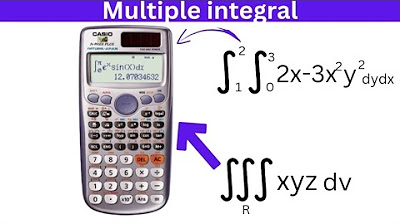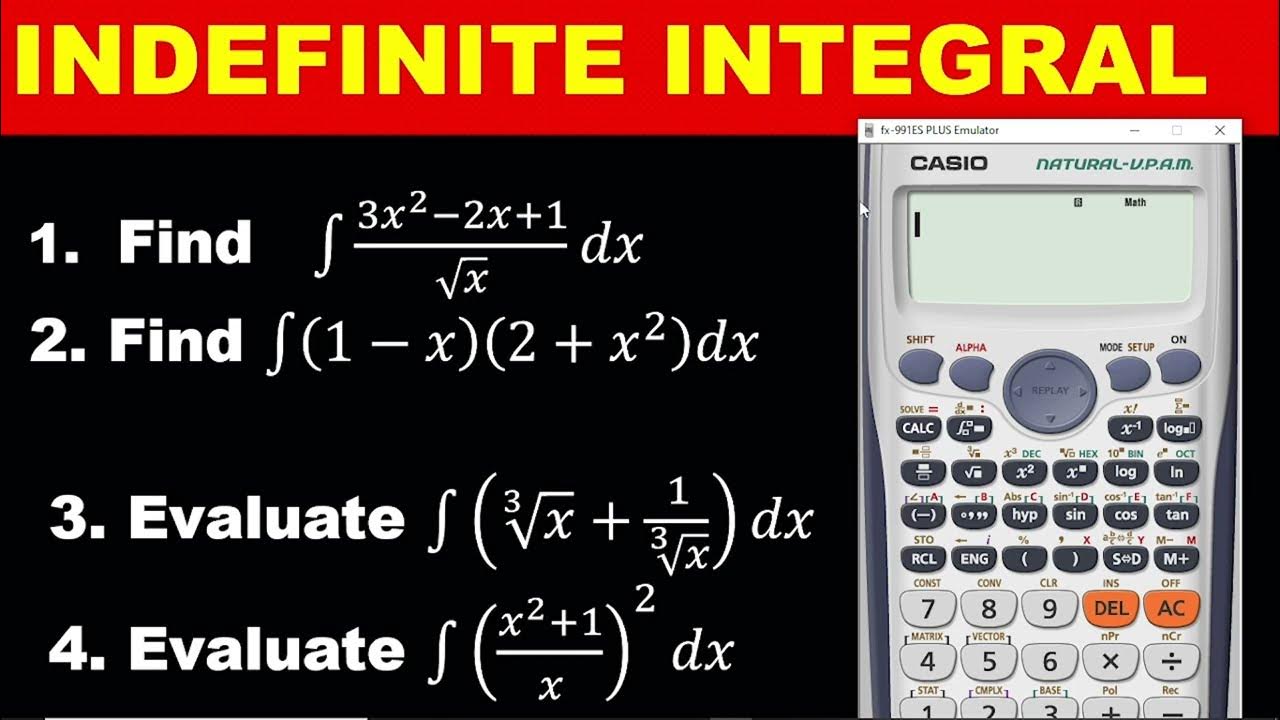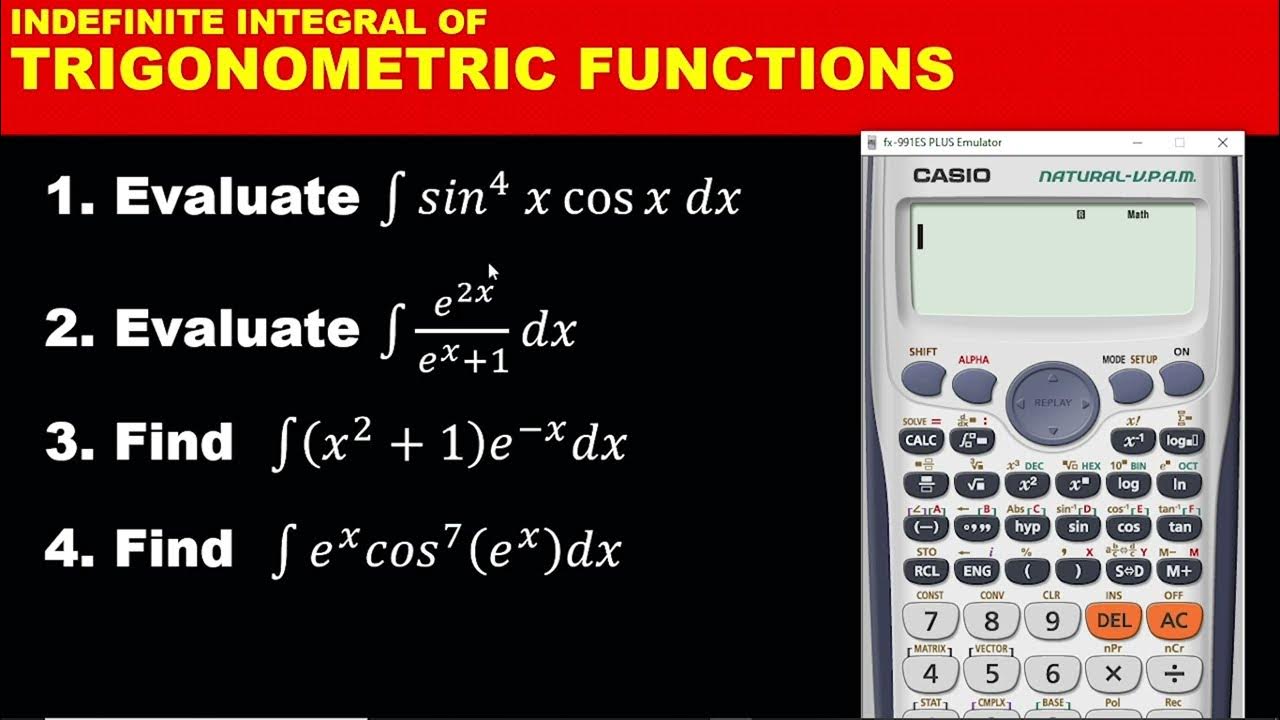Multiple Integrals Calculator Techniques - Engr. Yu Jei Abat | #AbatAndChill
TLDRThis video tutorial covers the use of calculator techniques to simplify the process of solving multiple integrals, including double and triple integrals. The instructor emphasizes the importance of setting the calculator to radian mode and correctly pairing integral limits. The video demonstrates step-by-step solutions to various integral problems, teaching viewers how to break down complex integrals into manageable single integrals and correctly input them into a calculator. By following the order of variables and matching them with appropriate integrals, even challenging integrals can be solved efficiently, showcasing the power of calculator techniques in simplifying mathematical computations.
Takeaways
- 🧮 Switch to radian mode on the calculator to accurately solve integrals involving trigonometric functions.
- 📘 Understand the order of integration: the first variable in the integral should be integrated first, followed by the outermost variable.
- 🔍 For double integrals, split them into single integrals and multiply their results to simplify the calculation.
- 🔢 When evaluating integrals, treat all variables as 'x' in the calculator, regardless of the actual variable used in the integral.
- ✅ For integrals involving 'dx', the calculator will automatically assume 'dx' when pressing the integral button.
- 📈 In the case of integrals with trigonometric functions, ensure the calculator is in radian mode for accurate results.
- 📉 For integrals with limits, first evaluate the innermost integral with its limits, then multiply by the outer integral with its limits.
- 📚 Practice distributing 'dx' and 'dy' to separate terms in a multiple integral for easier calculation.
- 📝 When solving integrals with constants, treat them as such in the calculator, as their placement does not affect the final result.
- 📉 For triple integrals, ensure the correct pairing of variables and their respective integrals, maintaining the order of integration.
- 🔑 Knowing the calculator techniques can significantly simplify the process of solving multiple integrals, making manual computation less necessary.
Q & A
What is the main topic of the video?
-The main topic of the video is solving multiple integrals using calculator techniques.
Why is it important to set the calculator to radian mode for problem number one?
-It is important to set the calculator to radian mode because the integral involves trigonometric functions, which are calculated in radians on most scientific calculators.
What is the first step in solving the double integral problem presented in the video?
-The first step is to set a pattern where the order of integration is maintained, with dy (dy/dx) coming before dx in the integral setup.
How should the double integral involving y^2 dy and x dx be rewritten for calculation?
-The double integral should be rewritten by splitting it into single integrals and then multiplying their products, with dy as the inner integral and dx as the outer integral.
What does the video suggest to do when the calculator does not have dy in the integral?
-The video suggests changing the y^2 to x^2 dx, treating y as x, since the calculator always yields dx when the integral function is pressed.
What is the result of the first integral problem solved in the video?
-The result of the first integral problem is -5/6.
How does the video approach the second problem involving three x plus x squared y?
-The video approaches the second problem by distributing dy and dx, separating them using the property of integrals, and then pairing dy with the appropriate part of the integrand and dx with another.
What is the final answer for the second integral problem presented in the video?
-The final answer for the second integral problem is 45.
How does the video handle the triple integral in problem number three?
-The video handles the triple integral by pairing x dx with the first integral, z squared dz with the second, and y dy with the third, treating all variables as x for the calculator.
What is the result of the triple integral problem in the video?
-The result of the triple integral problem is 27/4, which corresponds to choice eight.
What is the significance of maintaining the order of variables when using the calculator for integrals?
-Maintaining the order of variables is significant because it ensures that the calculator correctly evaluates the innermost and outermost integrals according to their respective limits.
How does the video suggest treating variables like y and z when using the calculator for integrals?
-The video suggests treating variables like y and z as x, since the calculator only handles integrals with respect to x.
What is the final answer for the simple double integral problem involving x sine y dy dx in the video?
-The final answer for the simple double integral problem is 1, which corresponds to letter A.
How does the video handle the last problem involving 40 dy dx and 2x y dy dx?
-The video handles the last problem by distributing dy and dx, treating all variables as x, and ensuring the proper integral for dy and dx is obtained.
What is the final answer for the last problem presented in the video?
-The final answer for the last problem is 112, which corresponds to choice D.
Outlines
📚 Introduction to Multiple Integral Calculator Techniques
The video begins with an introduction to the topic of multiple integral calculator techniques. The speaker emphasizes the importance of using a calculator in radian mode for solving double or triple integrals, which can often be complex to solve manually. The first problem is introduced, which involves setting up a double integral with variables x and y, and the speaker demonstrates how to correctly input the integral into the calculator by following a specific pattern where the order of integration is crucial. The example provided illustrates how to split a double integral into two single integrals and then multiply their results to get the final answer.
🔍 Distributing and Matching Integrals in Multiple Integrals
In the second paragraph, the speaker discusses how to handle integrals with multiple variables by distributing and matching them with their corresponding integrals. The example given involves a double integral with the function 'three x plus x squared y' and demonstrates the process of separating the integral into parts involving '3x' and 'x squared y'. The speaker explains how to pair each part with its respective integral and how to treat variables like y as x for the purpose of calculator input. The final step involves entering the integrals into the calculator and obtaining the result, which is 45 in this case.
📈 Solving Triple Integrals with Calculator Techniques
The third paragraph introduces the concept of solving triple integrals using calculator techniques. The speaker provides an example of a triple integral involving the functions 'x', 'z squared', and 'y', and explains how to pair each variable with its corresponding integral. The speaker then translates the variables into x for calculator input, showing the process of entering the integrals step by step. The final answer obtained from the calculator is 27/4, which corresponds to choice eight in a multiple-choice context.
📉 Evaluating Trigonometric Double Integrals with Calculators
In the fourth paragraph, the speaker tackles a simpler double integral involving the function 'x sine y' and demonstrates how to match the integral with its corresponding limits. The speaker points out the importance of setting the calculator to radian mode due to the presence of the trigonometric function sine. The process involves treating y as x and entering the integrals into the calculator to obtain the final answer, which is 1 in this case, corresponding to answer choice a.
🎯 Mastering Multiple Integral Calculator Techniques for Complex Problems
The final paragraph concludes the video with a reminder that knowing calculator techniques can simplify the process of solving even the most complex integrals. The speaker thanks the audience for watching and hints at future webinars or series that will delve deeper into multiple integral calculator techniques, encouraging viewers to stay tuned for more informative content.
Mindmap
Keywords
💡Multiple Integrals
💡Calculator Techniques
💡Radian Mode
💡Double Integral
💡Definite Integral
💡Trigonometric Functions
💡Variable Pairing
💡Integral Distribution
💡Order of Variables
💡Manual Computation
Highlights
Introduction to multiple integrals calculator techniques
Switching calculator to radian mode for accurate calculations
Understanding the order of integration variables in double integrals
Rewriting the integral to match the pattern of dy and dx
Splitting a double integral into single integrals for easier calculation
Changing variables in the integral to match the calculator's format
Evaluating the integral of x dx from negative three to two
Multiplying the results of single integrals to find the double integral
Distributing dy and dx in a complex integral expression
Matching integral limits with the order of variables in the integral
Solving a triple integral by pairing variables with their respective integrals
Treating all variables as x for simplification in the calculator
Calculating a triple integral step by step with the calculator
Using calculator techniques to simplify manual computation
Solving a simple double integral with x sine y dy dx
Ensuring the calculator is in radian mode for trigonometric functions
Final problem involving distribution and proper pairing of integrals
Emphasizing the importance of correct integral pairing for accurate results
Conclusion on the effectiveness of calculator techniques for multiple integrals
Transcripts
Browse More Related Video

How to use Calculator for Evaluate Multiple Integrals - Easy Techniques

Changing the Order of Integration (Double Integrals)

TI-89 Calculator - 03 - Calculating Indefinite and Definite Integrals in Calculus

LIMITS CALCULATOR TECHNIQUES - DIFFERENTIAL CALCULUS | ENGINEERING BOARD EXAM REVIEW | YU JEI ABAT

INTEGRATION PART 1: SIMPLE CALCULATOR TECHNIQUES FOR SOLVING INDEFINITE INTEGRAL- WASSCE MATHS

INTEGRATION PART 2: CALCULATOR TECHNIQUES ON INDEFINITE INTEGRATION OF TRIGONOMETRIC FUNCTIONS
5.0 / 5 (0 votes)
Thanks for rating: